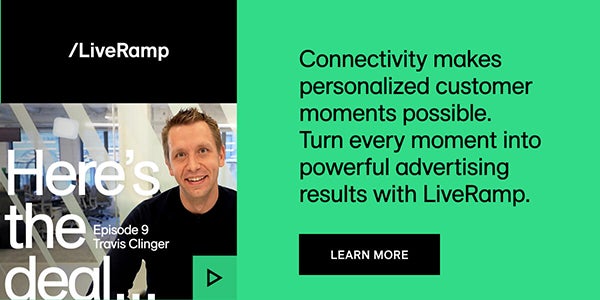The need for addressability has been a rallying cry among advertisers for the past five years, as they search for targeting and measurement alternatives in a privacy-centric world. But clinging to outdated notions of addressability means overlooking the broader needs of today’s modern media landscape.
Advertisers need to think bigger, connecting the totality of the consumer experience beyond just media. This extends far past traditional digital display, encompassing connected TV, mobile apps, AI-driven search, emerging AI-powered interfaces and the broader spectrum of technology integrations.
Achieving this expansive vision requires a shift from the addressability mindset to embrace a future of connectivity, where brands can more seamlessly personalize, optimize and measure across the entirety of the consumer experience.
The limits of addressability
Addressability emerged as a way to preserve the status quo with a focus on making media experiences addressable in the face of third-party cookie deprecation. But consumer interactions have exploded to include a wide range of connected experiences beyond traditional media. Relying on display addressability and device IDs leads to fragmented customer views and hinders effective measurement and optimization across this growing range of consumer touch points.
Think about it: Your customer might see a CTV ad, then engage with a brand’s chatbot and later receive an SMS message. These are all consumer experiences, but today they are often treated in silos and are difficult to comprehensively measure. This makes it hard for marketers to understand the full customer journey and deliver the relevant experiences consumers expect.
The continued march toward a more privacy-centric future – with tightening privacy regulations and further data deprecation – only exacerbates these limitations. Clearly, it’s time to evolve our addressability approach.
Connectivity: A strategic imperative
Connectivity is a holistic approach that makes all consumer experiences personalized, optimizable and measurable. It enables a unified view of the customer across channels, devices and experiences. This includes not only traditional media but also the dynamic realms of mar tech (email, SMS), emerging media (gaming, Internet of Things) and AI-powered experiences (AI search, chatbots) – as well as others yet to come.
Connectivity in action: This is what progress looks like
Connectivity isn’t a theory, however; it’s happening now, and the world’s biggest advertisers are taking advantage.
At LiveRamp, we’re seeing leading brands and top digital marketers apply this new approach across three key phases of their campaign strategy:
- Personalization: Connectivity aims to give marketers the tools to tailor messages within a much broader set of consumer experiences. For example, imagine a consumer using an AI search app. With connectivity, marketers are working toward the ability to deliver personalized brand messages within this new search experience, ensuring relevance and enhancing the user experience.
- Measurement: In addition to breaking the silos between paid and owned media, the connectivity approach enables measurement across all of these channels, creating a truly unified view of customer journeys. Using solutions like Conversion APIs and unifying measurement across critical touch points, such as retail, allows marketers to connect their advertising with business metrics.
- Optimization: Instead of waiting for lagging indicators and adjusting campaign strategy post hoc, connectivity enables real-time optimization based on conversion data and intent signals. For instance, if a consumer shows a strong interest in a product on a website, that signal should be used to optimize ad delivery across other channels.
As connectivity scales, marketers are gaining the capability to extend data-driven strategies to emerging frontiers, including AI-powered touch points, and to forge more meaningful connections with consumers.
For example, LiveRamp is pioneering strategic partnerships that extend connectivity into AI-powered experiences. Marketers are using these advancements today to personalize interactions within AI-driven search and to connect with custom audiences across social platforms with greater precision and relevance.
The future is connected
The advertising landscape is shifting, as AI upends traditional digital channels and device and channel proliferation expands the landscape of connected experiences. In this broader landscape, connectivity is the only path forward. Advertisers must transition beyond focusing on display and device addressability and propel themselves into the future across AI search, AI chatbots, owned media, mar tech and every tech integration imaginable.
This shift isn’t just about adapting to change; it’s about leading it.
As more brands embrace the power of connectivity, we’ll see a transformation in how they engage with consumers. They’ll be able to deliver relevant messages to people who want to see them, driving increased sales and a higher return on investment. Publishers and commerce media partners will discover innovative and more effective ways to monetize their data. And consumers will finally get what they’ve been demanding: advertising that is relevant, helpful and enhances their experiences.
Connectivity is the key to unlocking this future in which advertising is more effective, more efficient and more valuable for everyone.
For more articles featuring Travis Clinger, click here.












